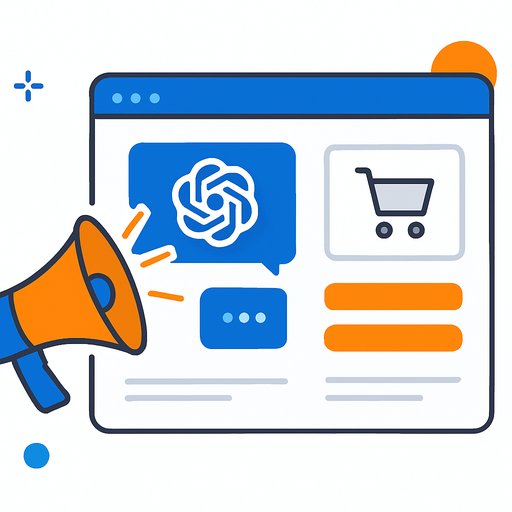ChatGPT Ads Are Coming Into View: A Practical Brief for Marketers
OpenAI appears to be preparing an ad-supported layer for ChatGPT. Hiring signals and product moves point to on-platform marketing tools and paid growth infrastructure that could turn the chatbot into an ad-capable surface.
For marketers, this is the start of a new channel: conversational inventory with intent-rich signals, measurable responses, and commerce hooks built into the interface.
What's Changing (and Why It Matters)
A job listing for a Growth Paid Marketing Platform Engineer suggests OpenAI is building internal tools for ad platform integration, campaign management, and real-time attribution as part of a "ChatGPT Growth team." Reports also point to expanding marketing reach and on-platform tools that support paid programs.
OpenAI has been moving ChatGPT toward an app platform, with third-party integrations (e.g., Spotify, Canva) running directly in chat. With heavy compute costs and plans for massive infrastructure, ads could complement subscriptions and API revenue without disrupting core usage-if executed with clear labeling and controls.
How Ads Could Appear Inside Chat
- Sponsored suggestions in responses: Context-aware units that surface products, services, or apps when users ask for solutions.
- In-chat commerce: Merchant partnerships enabling purchases without leaving the thread, with potential commissions to OpenAI.
- App and GPT placements: Paid visibility for tools, plug-ins, or custom GPTs inside discovery surfaces.
- Lead gen and bookings: Structured actions (demos, trials, calls) captured directly from the conversation.
Expect early formats to prioritize utility over interruption. The winning creative will feel like a helpful next step, not a banner wedged into a dialogue.
Privacy, Disclosure, and Trust
Blending organic assistance with sponsored content raises obvious trust questions. Clear labels, consistent placement, and user controls will be essential.
Plan for a privacy-forward approach: minimal targeting by default, transparent data use, and opt-ins for personalization. Treat first-party data and consent as non-negotiable.
Signals From Leadership and Reporting
OpenAI leadership has hinted that relevant, well-placed ads could be acceptable if they genuinely help users. Industry reports also note internal discussions about advertising as a revenue stream and the pressure to fund large compute investments.
At the same time, the company has stated there are no immediate ad plans. Expect testing, tight guardrails, and a slow rollout focused on quality over volume.
Competitive Context
Google, Anthropic, and others are watching. If ChatGPT ads convert and maintain user satisfaction, rivals may introduce similar offerings to defend attention and budgets.
This could trigger a new category: conversational performance marketing. The competitive edge will go to teams that marry high-intent prompts with fast, frictionless outcomes.
What Marketers Should Do in the Next 90 Days
- Define conversational outcomes: Map prompt-to-action flows for your top use cases (trial, demo, checkout, content download).
- Build chat-native creative: Short, directive copy; structured offers; clear CTAs; answer objections in a single exchange.
- Prep measurement: Set up real-time attribution, offline conversion capture, and clean UTM conventions. Pair with MMM for guardrails.
- Strengthen first-party data: Consent flows, preference centers, and clean CRM fields ready for API syncs.
- Set brand safety rules: Allowed categories, disclosure requirements, and escalation paths for sensitive prompts.
- Pilot conversational commerce: Test checkout and lead flows that can run inside a chat experience.
Creative and Targeting Principles That Will Likely Win
- Utility first: Provide instant value that shortens the path to the result the user asked for.
- Context match: Tie the offer to the precise intent in the prompt, not broad personas.
- Proof over polish: Use outcomes, benchmarks, and social proof in one or two lines-skip fluff.
- Fast actions: One-click trials, instant bookings, or prefilled forms to reduce drop-off.
Risks and Guardrails to Plan For
- Disclosure: Sponsored responses must be unmistakable. Push for consistent visual and textual labels.
- Bias and fairness: Monitor for skewed recommendations. Maintain audit logs of prompts and outcomes.
- User experience: Avoid interruptive placements. Prioritize formats that feel like an assist, not an ad break.
- Data governance: Treat chat content as sensitive. Limit retention and apply strict access controls.
Bottom Line
ChatGPT is likely to open paid pathways where helpful, relevant ads and commerce actions live inside the conversation. The upside for marketers is high-intent reach with measurable actions and lower friction.
Start building chat-native creative, clean measurement, and first-party data foundations now. The teams that prepare early will win the best placements and learnings when tests go live.
Further Learning
Your membership also unlocks:






